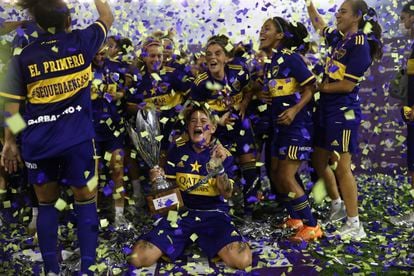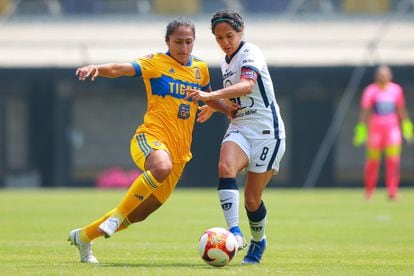Latin America keeps the flame of women’s soccer alight despite the pandemic
Mexico, Chile and Brazil are leading the way in driving the sport in the region but sexism and inequality remain the primary matters to address

The men play in huge stadiums while the women ply their trade on training grounds. The former are paid thousands of dollars a week, the latter need secondary jobs to get by. Women’s soccer in Latin America has been slow to take off in some countries. Inequality has stunted the growth of the sport across the region and the Covid-19 pandemic delivered another hard knock but female players are managing to keep the flame alight.
“The clubs have got to step up for women’s soccer. Someone who plays soccer in Peru does so because they love the game, not in order to earn money,” says Miryam Tristán, the Peru national team’s star forward.
“In Argentina a women’s first division player earns the same as a male player in the fourth tier [around $350]. And not all of them get paid,” adds Argentine journalist Ayelén Pujol.
Mexico, Chile and Brazil have positioned themselves at the forefront of women’s soccer in Latin America although serious issues still remain, including sexism within clubs and wage inequality. FIFA has offered $500,000 – an amount male players in Europe can earn in a month – to member countries to drive women’s soccer in the face of the economic crisis and the closure of stadiums.
Colombia facing uncertainty
Colombian soccer has produced more than enough results to warrant greater support. Over the past decade the national side has been runner-up twice at the Copa América (2010 and 2014), qualified for the World Cup twice (2011 and 2015) and the Olympics twice (2012 and 2016) in addition to winning the 2019 Pan American Games.
In the final of the inaugural season of the professional Colombian Women’s Football League in 2017, Independiente Santa Fe beat Atlético Huila to the title in the El Campín stadium in Bogotá in front of 30,000 spectators. Huila won the tournament the following season and also claimed the continental Copa Libertadores trophy. But the players were confronted with demeaning working conditions and a hostile atmosphere.
Isabella Echeverri and Melissa Ortiz broke their silence in a video in 2019, in which they highlighted irregularities in the way women’s soccer was being run: the federation failed to pay their wages, they were obliged to cover their own travel and medical costs, their kits were old or second-hand and those players that dared to speak out were left out of the team. Their complaints resonated strongly but also caused a rift with the hierarchy that continues to this day.
Several of the Colombia team play abroad: Echeverri and Natalia Gaitán are teammates at Sevilla while Leicy Santos plays for Atlético Madrid in the comparative riches of the Spanish league. At home, the Colombian Women’s Football League has been marked by a constant struggle against job insecurity. Since 2018 both the number of participating teams and the length of the season have been reduced. América de Cali won the third league title in 2019, which was contested by 20 teams over less than three months. Santa Fe repeated their triumph last season amid the pandemic in a tournament that lasted 58 days and featured 13 teams. The 2021 season is projected to take place across 45 days with an as-yet unknown number of teams taking part.

Marta’s feet didn’t entirely kick down walls
Brazil has historically been one of the most active countries in working against the progress of women’s soccer: women were banned from playing between 1941 and 1979. One of the first women’s teams was called Radar FC, which formed the basis of the national side in the 1980s and of the first Brazil team to compete at the World Cup, in 1991. Then came the golden generation of Marta and Cristiane. The Canarinha have won the Copa América seven times and have been runners-up at the Olympics twice (2004 and 2008) and at the 2007 World Cup.
In 2013, the Brazilian Football Federation launched the professional Série A league to replace the previous semi-professional tournaments. The first champions, Centro Olímpico, won a tournament contested by 20 teams but only one of those was part of a men’s professional club, Vasco de Gama.
Since then, the Brazilian league has grown in popularity to the extent that in 2019 the federation required clubs playing in the men’s division to have both a women’s team and youth teams. The tournament now has teams from eight of the biggest clubs in Brazilian men’s football led by Corinthians, who have had gates of over 20,000 at the stadium used by the men’s side, although it is unusual for a women’s side to ground share in Brazil.
Argentina: soccer beyond Buenos Aires the goal
Women have been playing soccer in Argentina since 1913 but it was not until 1991 that the first official women’s league was created and only in 2019 were steps taken to further professionalize the division. Argentine Football Association rules state that clubs must have at least eight players on a contract, which is to say there are players who don’t get paid at all. “There are many players who have another job as well as football,” says Ayelén Pujol, author of the book ¡Qué jugadora!: un siglo de fútbol femenino en Argentina (or, What a player! A century of women’s football in Argentina). “Players tend to try and go abroad as even though they don’t get paid that much in Europe, they can develop their game better there.”
The biggest teams in women’s football are Boca Juniors, River Plate and UAI Urquiza and Buenos Aires clubs tend to dominate the league. “One of the main requirements is that the tournament should be more federal because soccer is growing a lot,” says Pujol. Several clubs open their stadiums for their women’s sides and games are broadcast on some of the main television channels.
“There are more and more fans following the women, so public opinion is demanding to see more games,” Pujol adds. Argentina reaching the World Cup in 2019 raised wider interest in the women’s game and players like Aldana Cometti, Mariana Larroquette and Soledad Jaimes became practically household names. The coronavirus pandemic led to the cancelation of the 2020 season and this year, as in the rest of the continent, fans are not allowed in stadiums.

Mexico shows support for women’s soccer
Mexico took its time over throwing its weight behind women’s soccer, despite blazing a trail by hosting the first World Cup in 1971, 20 years before world governing body FIFA officially embraced the tournament. Despite huge enthusiasm for the competition, with Denmark beating Mexico in the final, the grass roots game was marginalized. Non-professional tournaments kept the dreams of generations of players to dedicate themselves to soccer alive and like their counterparts in other countries players were forced to go abroad to seek opportunities, such as Charlyn Corral and Stephany Mayor, two of the most recognizable players in Mexican soccer today.
The first professional women’s league was formed in 2017 with 17 participating clubs. Since then, women’s soccer has been taken more seriously in Mexico. However, pay parity, equal treatment, a collective bargaining agreement and proper health insurance remain the chief matters to be addressed. The federation has pointed out that the competition has not yet managed to establish itself as a big business.
According to official statistics, there are 33.5 million fans of the women’s league in Mexico. Engagement has been key. In just four years the division has made important steps in being broadcast on television and games are increasingly played in the stadiums used by the men’s teams. Rayadas and Tigres, who both play in Monterrey, are two of the biggest women’s teams in terms of investment and results. A derby between the two sides set a continental record of 51,000 spectators, one only bettered at club level by the game between Atlético Madrid and Barcelona in March 2019 that drew 60,000 fans to the Wanda Metropolitano.
If one player symbolizes the progress of women’s soccer it is Mónica Vergara, who was part of the first Mexico side to play at the World Cup in 1999 and who had to hone her game in a country without a domestic league. She became a coach and achieved one of Mexican soccer’s greatest feats: taking the under-17s to a World Cup final. In 2021, she was appointed coach of the women’s senior side, a post held for more than 20 years by male coaches who had little tangible success.
Peruvian soccer remains in the shadows
The Peruvian women’s league was formed in 1999 when the men’s clubs set up their own women’s teams but since then the health of the division has deteriorated. “The championships weren’t of good quality because clubs didn’t face sanctions for not entering women’s teams,” says Miryam Tristán, the national team captain, who recalls that when she started out at Sporting Cristal at the age of 13 players had everything: training pitches, new kits, locker rooms… but these conditions would not last long. In 2019, the clásico between Alianza and Universitario was televised for the first time but that turned out to be an exception, not the rule.
Women’s games are generally held in different stadiums to the men’s and the availability of locker rooms is not taken for granted. “Sometimes there is no grass on parts of the pitch or there are watering pipes there and it can be dangerous,” Tristán says. “To have a pitch specifically for women’s football would be a privilege.” Players are not paid; instead they get a subsidy to cover travel costs.
The Peruvian women’s league is considered an amateur division yet clubs compete in the Copa Libertadores, the regional equivalent of the UEFA Champions League and one of the great projects for women’s soccer on the continent. The pandemic has restricted travel and national sides have also been largely unable to stage training camps or take part in friendlies. Over the course of 2020, the Peru national side only managed a few days of training in November and December.

Chile, a collective triumph
Players in Chile are eager to continue succeeding. In 2016, women’s soccer endured its lowest ebb when it was dropped from its own federation’s agenda. The support it had received since the foundation of the league in 2008 had evaporated and men’s clubs decided to cut their losses. However, the players took matters into their own hands and formed the National Association of Women’s Soccer Players (Anjuff), a kind of trade union to fight for their rights as athletes and to send a message to those who thought the opposite: women can make a dignified living from soccer.
The national side immediately reaped the dividends, qualifying for the 2019 World Cup after finishing runners-up at the Copa América. Domestically Colo Colo have been the principal backers of women’s soccer, resulting in 13 league titles and a Copa Libertadores victory in 2012. The pandemic led to the cancelation of the league last year but another substitute tournament was successfully staged.
“Many of those in charge of soccer don’t understand that the game is there for women as much as men and we deserve the same conditions. They also don’t understand that it is good business. Their sexism is so ingrained that they can’t even see something they love so much: money and business opportunity,” former Chile international Iona Rothfeld, a founder member of Anjuff who has now turned her attention to politics, told Contragolpe. Chile’s soccer players recently added another first to their pioneering campaign when they presented a protocol against harassment and sexual abuse in sport.
Despite the obstacles, women’s soccer in Latin America is determined to forge ahead with its goals.
English version by Rob Train.

/cloudfront-eu-central-1.images.arcpublishing.com/prisa/VBZ57UN7VK2NBYFMHWW27ADMAU.jpg)










































